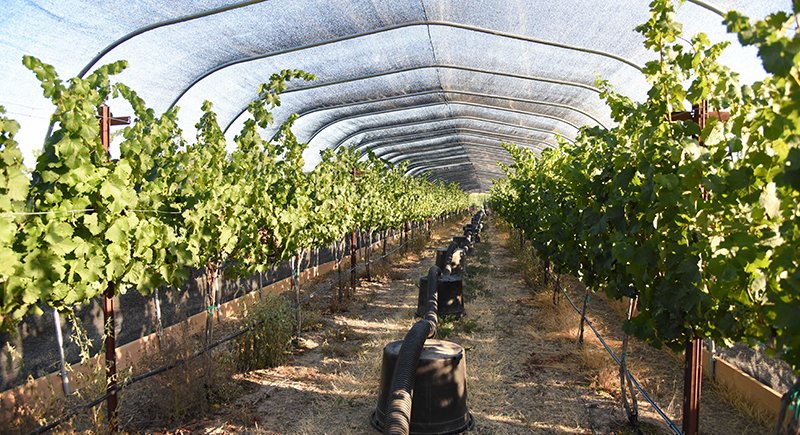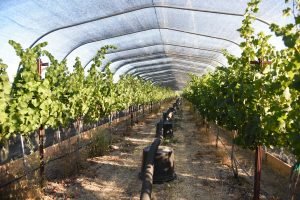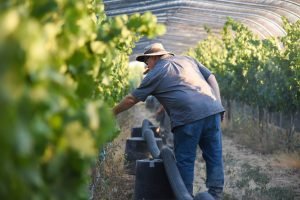
August 16, 2016 Grape vines exposed to smoke to test taint from wildfires
By Maegan Murray, WSU Tri-Cities
RICHLAND, Wash. – Wine grapes may appear fine after a harsh wildfire season. But if grapes have smoke taint, the finished wine may taste and smell awful – an unpleasant surprise for growers and wine lovers alike.
“The aroma you get from smoke taint in wine is not a pleasant campfire aroma,” said Tom Collins, Washington State University Tri-Cities assistant professor of viticulture and enology. “The best-case comparison is smoked fish, but it can be more like ash tray.”
Changes in chemical composition
 In a new study, Collins is exposing vines to smoke to better understand how the chemical composition of grapes changes. He wants to know how much smoke it takes to create smoke taint in wine grapes and wine, as well as how to lessen the problem.
In a new study, Collins is exposing vines to smoke to better understand how the chemical composition of grapes changes. He wants to know how much smoke it takes to create smoke taint in wine grapes and wine, as well as how to lessen the problem.
He will examine samples of leaves and fruit, then make wine from the grapes for chemical analysis. He uses a smoker to pump fumes into a hoop house with 60 riesling vines. A second house of vines acts as a control. He is doing the same study on cabernet grapes.
Taint is invisible on the leaves or fruit, but appears when wine is made, influencing aroma and aftertaste. Severity of taint depends on the number and size of wildfires in a season, as well as movement of smoke. Not all wines made during severe fire seasons are tainted with smoke, Collins said.
“California had an issue with it from the 2008 vintage,” he said. “Washington has had issues with smoke-affected wines as well. It’s enough of a problem we need to look at it more closely.”
Smoky surprise
Smoke taint is created by compounds in the smoke that bind with sugar molecules to form glycosides.
“When present as glycosides, you cannot smell the smoke in the grapes,” Collins said. “But because wine is acidic, these glycosides break down, releasing the smoke compounds. Over time, the smoky aromas become apparent.”
He said there is evidence that the same thing happens when a person drinks the wine.
“When the enzymes in your mouth break down these glycosides in wine, they release the free compounds as you taste it,” he said. “Some of these wines don’t smell that bad, but when you taste them, you get an ashy character in the aftertaste.”
Replicates exposure from wildfires
In either case, the problem can be identified by chemical testing during the winemaking process.
There are ways to remove free compounds from the wine, but no effective ways to remove glycosides, Collins said.
“In the lab, you can hydrolyze the glycosides by heating the wine at low pH, but that is only for analysis,” he said. “It’s not a commercial practice.”
Most research that has been done so far is based on high intensity smoke for short periods of time. It is hard to smoke a vineyard for an extended period of time because of heat buildup, Collins said.
“What we are trying to replicate here is low intensity smoke for an extended period of time, which is more typical of actual smoke exposure from wildfires,” he said.
The first year of trials will demonstrate smoking methods, followed by research on how variables like fuel source, grape variety and time of year impact the severity of smoke taint.
Contacts:
Tom Collins, WSU Tri-Cities wine science, 509-372-7515, tom.collins@wsu.edu
Maegan Murray, WSU Tri-Cities public relations specialist, 509-372-7333, maegan.murray@tricity.wsu.edu




